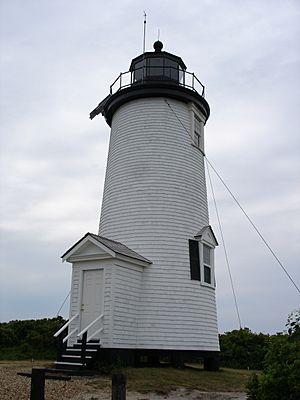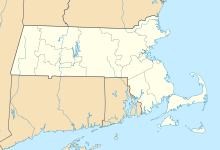Cape Poge Light facts for kids
 |
|
|
|
|
| Location | Chappaquiddick Island, Edgartown, Massachusetts |
|---|---|
| Coordinates | 41°25′9.992″N 70°27′8.348″W / 41.41944222°N 70.45231889°W |
| Year first constructed | 1801 |
| Year first lit | 1893 (current tower) |
| Automated | 1943 |
| Foundation | Stone |
| Construction | Wood shingle |
| Tower shape | Conical |
| Markings / pattern | White with black lantern |
| Focal height | |
| Original lens | Fourth order Fresnel lens |
| Current lens | 12 inches (300 mm) |
| Range | 9 nautical miles (17 km; 10 mi) |
| Characteristic | Flashing white 6s |
| Fog signal | none |
| Admiralty number | J0438 |
| ARLHS number | USA-132 |
| USCG number | 1-13715 |
The Cape Poge Light, also known as Cape Pogue Light, is a historic lighthouse. You can find it at the very northeast tip of Chappaquiddick Island. This island is part of Martha's Vineyard, which is off the coast of Cape Cod, Massachusetts. Lighthouses like this one help guide ships safely.
Contents
A Lighthouse on the Move
The Cape Poge Light has a very interesting history. It has been built and moved many times! This is because the land it sits on, a bluff, slowly wears away from the ocean.
The First Lighthouses
The very first lighthouse at Cape Poge was built in 1801. It was a wooden tower, about 35-foot (11 m) tall. During the War of 1812, the light had to be turned off. Its important parts were hidden away for safety.
Because the land was eroding, this first lighthouse was moved in 1825. It was moved again in 1838 to keep it safe from the sea.
In 1844, a brand new tower was built. This one was later given a special Fresnel lens in 1857. A Fresnel lens makes the light much brighter and easier to see. But the land kept eroding! By 1878, people worried the keeper's house would fall into the ocean. So, a third lighthouse was built in 1880.
The Current Tower's Journey
The lighthouse you see today was built in 1893. It's a white, 35-foot (11 m) tall wooden tower. It was built about 40 feet (12 m) further inland than the one before it.
Even this current tower has been moved four times! It was moved in 1907, 1922, 1960, and then again in 1987. The 1987 move was very special. It was the first time a lighthouse was moved using a helicopter! Imagine seeing a lighthouse flying through the air!
The light itself became automated in 1943. This means it no longer needed a person, called a "keeper," to light it every night. In 1987, the lighthouse was added to the National Register of Historic Places. This means it's an important historical site.
What the Light Does Today
Today, the Cape Poge Light uses a 12-inch (300 mm) solar-powered beacon. This light flashes white every 6 seconds. It can be seen from about 9 nautical miles (17 km; 10 mi) away! The light shines from 65 feet (20 m) above the water.
The United States Coast Guard used to be in charge of the light. But now, a group called The Trustees of Reservations owns and operates the tower. They even offer tours during the summer!
You can reach the lighthouse by hiking about 3.5-mile (5.6 km) from the Dike Bridge. Or, if you have a special vehicle, you can drive there.
Famous Movie Appearance
The Cape Poge Lighthouse even made it into a famous movie! You can spot it in the final two scenes of the film "Jaws". Look closely to the right side of the screen as the main characters, Roy Scheider and Richard Dreyfuss, swim back to shore.
Lighthouse Keepers
For many years, dedicated people called lighthouse keepers lived and worked at Cape Poge. They made sure the light was always shining to guide ships. Some of the early keepers included Mathew Mayhew (1801), Lott Norton (1835), and George Ripley Marchant (1859). The last keeper was Joseph H. DuBois, before the light became automated in 1943.


